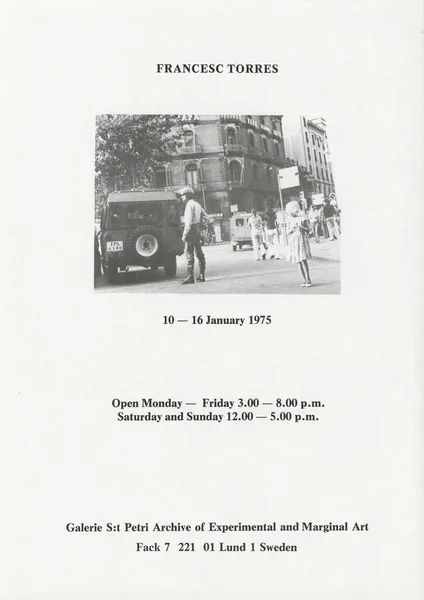CLICK TO VIEW PRESS RELEASE

FRANCESC TORRES10.01-16.01.1975
1
During wartime, or in other words, during time of organized violence as an integral and normal way of life for each one of the fighting groups, a specific vital space is produced as a substitution for the normal vital space in peace time. For example, the bomb shelter substitutes for the house or apartment. In the U.S., during the McCarthy era and in the middle of the cold war, the atomic shelter was commercialized and could be built for a few thousand dollars, in the garden, cellar or backyard of the house. They are hermetic structures made of concrete with the capacity for an average family featuring air conditioning, food storage, etc. Many of them can still be found, used as playing rooms for the kids equipped with ping-pong tables and similar things.
One of the most significant spaces in martial architecture is the bunker, a fixed defense cell of reduced dimensions with the capacity for two or more men depending whether it is a machine gun post or an artillery post. You always find the bunker generally isolated, despite its being part of a larger defense complex. In this fixed cell, watching and waiting become the companions of a crew obliged to use such a space as a home, during prolonged periods of time.
When the biggest worry is self-protection, one doesn’t have the time to feel oneself.
After a certain time of living in the same place, one observes and discovers the spots and chips on the wall and ceiling. Little by little one discovers faces, animals, which after being fixed in your mind will never abandon the place that belongs to each one of them. Sometimes you will give names to them, but not indiscriminately: only to the ones which have seized one part of the life of the discoverer.
For the person inside, the basic function of the bunker is to protect the physical and psychological integrity of the person inside. The occupant needs to think that he is in a position of advantage and the bunker offers him this belief just by its appearance, although this is not necessarily true. The subject’s unconscious responds to this with confidence; the bunker is
Even in the worst circumstances it is sad to abandon the space where we lived, the corner where we ate and slept, the wall over which somebody wrote a name or a sentence “Here lived Felipe Torrado. 10/8/38”
one of the architectural spaces which is most closely related to the maternal womb in subjective terms through its protection of the individual against the exterior hostility which has to be confronted alone.
One of the many things the bunker hides is its own weakness. It also hides the fear of the men inside, the tedium and the ways of fighting it, some of them difficult to justify to the
Masturbating is one way of making sure that you are still alive, that you can still generate manufacturers of customs, if they would follow beyond the wall that produce them. Logistically, that you still have a sensitive body. When this is not sufficient, when the fantasies that cross the mind while playing with yourself cannot compete with the surrounding reality, is
2
target for the mobile units and a trap for its occupants. War documentaries show bunkers when a companion may try to substitute for them. It all will depend on how we take the being attacked by flame-throwers forcing the soldiers inside to jump out, in flames like torcontext we are living in.
ches: the luckiest of them being killed in euthanasia by the enemy.
Despite everything, the bunker, this shelter of female nature when it appears in dreams, seems inexpugnable when looking at it straight, from the distance.
Every act of violence has a sexual equivalent. We still don’t know (is it still forbidden?) how to separate things.
Crossed out in black:
“Close to Llança exists the remains of a parallel city which was abandoned in 1939.”


